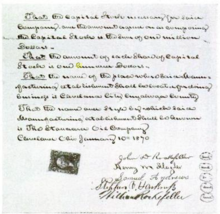Business and Standard Oil[edit]
After the failure of his salt business in Saginaw, Flagler returned to Bellevue in 1866 and reentered the grain business as a commission merchant with The Harkness Grain Company. During this time he worked to pay back Steve Harkness. Through this business, Flagler became acquainted with John D. Rockefeller, who worked as a commission agent with Hewitt and Tuttle for the Harkness Grain Company. By the mid-1860s, Cleveland had become the center of the oil refining industry in America and Rockefeller left the grain business to start his own oil refinery. Rockefeller worked in association with chemist and inventor Samuel Andrews.
Needing capital for his new venture, Rockefeller approached Flagler in 1867. Flagler obtained $100,000 (equivalent of $1.7 million in 2015) from family member Stephen V. Harkness on the condition that Flagler be made a partner. The Rockefeller, Andrews & Flagler partnership was formed with Flagler in control of Harkness' interest.[5] The partnership eventually grew into the Standard Oil Corporation. It was Flagler's idea to use the rebate system to strengthen the firm's position against competitors and the transporting enterprises alike. Flagler was in a special position to make those deals due to his connections as a grain merchant. Though the refunds issued amounted to no more than fifteen cents on the dollar, they put Standard Oil in position to undercut other oil refineries.[6] By 1872, it led the American oil refining industry, producing 10,000 barrels per day (1,600 m3/d). The Flagler family moved to New York in 1877 since New York was becoming the center of commerce in the US. In 1885, Standard Oil moved its corporate headquarters to New York City to the iconic 26 Broadway location.
By the end of the American Civil War, Cleveland was one of the five main refining centers in the U.S. (besides Pittsburgh, Pennsylvania, New York, and the region in northwestern Pennsylvania where most of the oil originated).
By 1869, there was three times more kerosene refining capacity than needed to supply the market, and the capacity remained in excess for many years.[7] In June 1870, Flagler and Rockefeller formed Standard Oil of Ohio, which rapidly became the most profitable refiner in Ohio. Standard Oil grew to become one of the largest shippers of oil and kerosene in the country. The railroads were fighting fiercely for traffic and, in an attempt to create a cartel to control freight rates, formed the South Improvement Company in collusion with Standard and other oil men outside the main oil centers.[8] The cartel received preferential treatment as a high-volume shipper, which included not just steep rebates of up to 50% for their product but also rebates for the shipment of competing products.[8] Part of this scheme was the announcement of sharply increased freight charges. This touched off a firestorm of protest from independent oil well owners, including boycotts and vandalism, which eventually led to the discovery of Standard Oil's part in the deal. A major New York refiner, Charles Pratt and Company, headed by Charles Pratt and Henry H. Rogers, led the opposition to this plan, and railroads soon backed off. Pennsylvania revoked the cartel’s charter, and non-preferential rates were restored for the time being.[9]



No comments:
Post a Comment